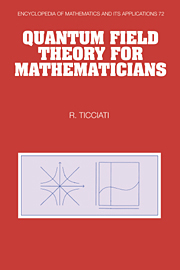Book contents
- Frontmatter
- Contents
- Preface
- Introduction
- 1 Relativistic Quantum Mechanics
- 2 Fock Space, the Scalar Field, and Canonical Quantization
- 3 Symmetries and Conservation Laws
- 4 From Dyson's Formula to Feynman Rules
- 5 Differential Transition Probabilities and Predictions
- 6 Representations of the Lorentz Group
- 7 Two-Component Spinor Fields
- 8 Four-Component Spinor Fields
- 9 Vector Fields and Gauge Invariance
- 10 Reformulating Scattering Theory
- 11 Functional Integral Quantization
- 12 Quantization of Gauge Theories
- 13 Anomalies and Vacua in Gauge Theories
- 14 SU(3) Representation Theory
- 15 The Structure of the Standard Model
- 16 Hadrons, Flavor Symmetry, and Nucleon-Pion Interactions
- 17 Tree-Level Applications of the Standard Model
- 18 Regularization and Renormalization
- 19 Renormalization of QED: Three Primitive Divergences
- 20 Renormalization and Preservation of Symmetries
- 21 The Renormalization Group Equations
- Appendix
- References
- Index
20 - Renormalization and Preservation of Symmetries
Published online by Cambridge University Press: 31 October 2009
- Frontmatter
- Contents
- Preface
- Introduction
- 1 Relativistic Quantum Mechanics
- 2 Fock Space, the Scalar Field, and Canonical Quantization
- 3 Symmetries and Conservation Laws
- 4 From Dyson's Formula to Feynman Rules
- 5 Differential Transition Probabilities and Predictions
- 6 Representations of the Lorentz Group
- 7 Two-Component Spinor Fields
- 8 Four-Component Spinor Fields
- 9 Vector Fields and Gauge Invariance
- 10 Reformulating Scattering Theory
- 11 Functional Integral Quantization
- 12 Quantization of Gauge Theories
- 13 Anomalies and Vacua in Gauge Theories
- 14 SU(3) Representation Theory
- 15 The Structure of the Standard Model
- 16 Hadrons, Flavor Symmetry, and Nucleon-Pion Interactions
- 17 Tree-Level Applications of the Standard Model
- 18 Regularization and Renormalization
- 19 Renormalization of QED: Three Primitive Divergences
- 20 Renormalization and Preservation of Symmetries
- 21 The Renormalization Group Equations
- Appendix
- References
- Index
Summary
Developing the theory of renormalization in order to extend renormalization from primitive divergences to all diagrams and demonstrate preservation of global and local symmetries.
Introduction
Chapter 4 opened the topic of renormalization, indicating the need for counterterms to balance divergent contributions to the scalar self-energy. There we also noted that interactions of mass dimension greater than four would generate an infinite tower of counterterms. Chapter 10 provided a foundation for renormalization in the theory of Green functions, and gave examples of the use of renormalization conditions in the computation of first-order corrections. Chapter 19 discussed the renormalization of the primitive divergences of QED in detail, introducing the use of a photon mass as an infrared regulator. In this chapter, we extend the theoretical foundation of renormalization and in particular justify the approach taken in Chapter 19.
Sections 20.1 and 20.2 present the renormalization procedure of Bogoliubov, Parasiuk, Hepp, and Zimmermann (BPHZ). This procedure is effectively the counterterm renormalization technique expressed in terms of Taylor series. It extends the renormalization techniques of the last chapter to all diagrams. Section 20.3 concludes the first unit of the chapter with some renormalization theorems which show that BPHZ renormalization preserves global symmetries.
At this point in the chapter, we still have no guarantee that renormalization will preserve a local symmetry.
- Type
- Chapter
- Information
- Quantum Field Theory for Mathematicians , pp. 596 - 630Publisher: Cambridge University PressPrint publication year: 1999



